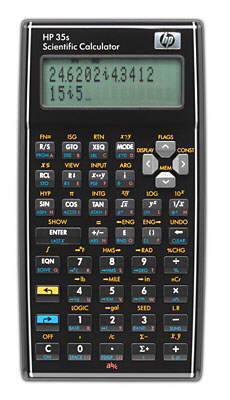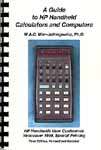Hewlett Packard HP-35
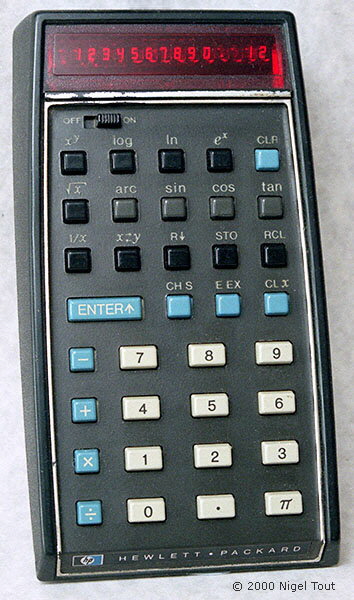
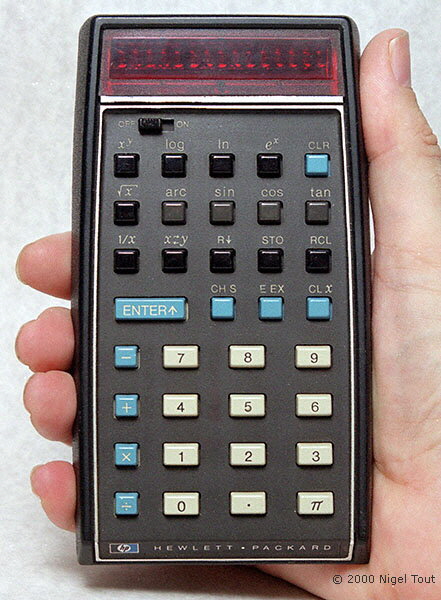
Hewlett Packard HP-35
Distinctive features: The first hand-held scientific calculator.
On April 14th 2009 Hewlett Packard was awarded the IEEE Milestone in Electrical Engineering and Computing for the HP-35 calculator for the first hand-held scientific calculator, the HP-35.
Technical details:
Display is scientific, 10 digits mantissa and 2 digits exponent, red LED.
Scientific, using Reverse Polish Notation (RPN) - as evidenced by the lack of an "=" key.
Main integrated circuits in this example - Mostek MK6020, MK6021, MK6022, MK6023, MK6024, which comprise an arithmetic and register chip, a control and timing chip, and three 256 x 10 bits ROMs. This chip set was also second-sourced by AMI (American Micro-systems Inc.).
3.75v (3 x AA re-chargeable).
79 mm x 147 mm x 34 mm (3.1" x 5.8" x 1.4").
Introduced February 1972, cost $395 (about £165 GBP).
Made in U.S.A. & Singapore.
The calculator illustrated above is an early example since it has no model number on the front, just 'Hewlett●Packard', since this was the only hand-held calculator then marketed by Hewlett-Packard. Later examples are labelled with the model number—'Hewlett●Packard 35', see below.
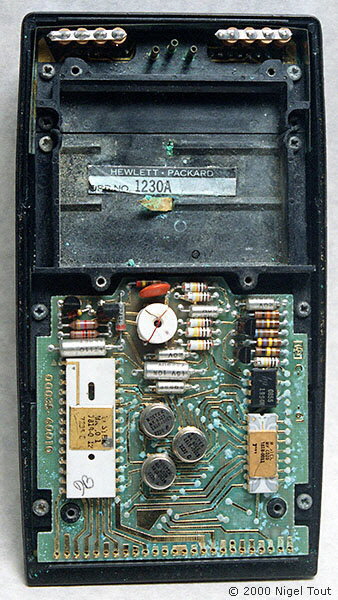
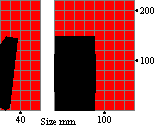
With the casing taken apart, revealing the circuit board with the integrated circuits.
The small ceramic package on the right is the MK6020 Arithmetic & Register Chip, the large ceramic package on the left is the MK6021 Control and Timing Chip, and the three cans in the middle are the MK6022, MK6023, and MK6024,
all 256 x 10 bits ROM chips. Here all chips are date-coded to late 1972.
The journal 'Electronic Design' had an announcement about the HP-35 in February 1972[1]:
"$395 LED calculator a 'slide rule'—and more
An electronic 'slide-rule' is on the market. It multiplies, divides, takes square roots, inverts, raises a number to a
power, takes ex and also sin, cos, tan, arc-sin, arc-cos and arc-tan. It can also add and subtract, and it has a memory for storing a constant. Several other machines on the market do all of these things but none that you can slip into your shirt pocket.
Built by the Hewlett-Packard Data Products Group in Cupertino, Calif., the calculator, designated HP-35, costs $395. According to Alexis Sozonoff, the company manager of advanced products in Cupertino, "Competing calculators cost at least $1500 and must be used on a table because of their size."
The HP machine presents the answers to problems on an array of LED numeric seven-segment displays to 10 significant decimal digits.
Sozonoff notes that the HP-35 contains most of its circuitry on five MOS/LSI chips. The five chips were designed by Mostek of Carolltown, Tex., and American Micro-systems, Inc. of Santa Clara, Calif. Three of the chips are ROMs that perform the special function key operations. One is for timing, synchronization and other control functions. And the fifth is the arithmetic chip that contains logic and registers. All five chips are made with an ion-implanted, p-channel, low-threshold process.
William R. Hewlett, president of Hewlett-Packard points out: "One of the difficult problems was that of fitting the necessary 35 keys on a very small keyboard in such a way that they would still be usable."
The unit measures only 3 x 6 x 1 inches and weighs a mere nine ounces. A unique keyboard designed by HP uses spring beryllium-copper to make contact when a keyboard switch is depressed.
Fifteen LEDs are used in the display. One is for the sign, ten are decimal digits, one is a decimal point and three others are for the exponent. These LEDs have a built-in magnifying lens to make them appear quite large. They are made by HP in Palo Alto and are packaged five digits to a plastic package. HP plans to announce these LEDs as standard products shortly.
Three rechargeable Ni-Cd batteries give the unit about three hours of life between rechargings. However, while the batteries are recharging, the calculator can be operated off conventional 115 or 230 V ac."
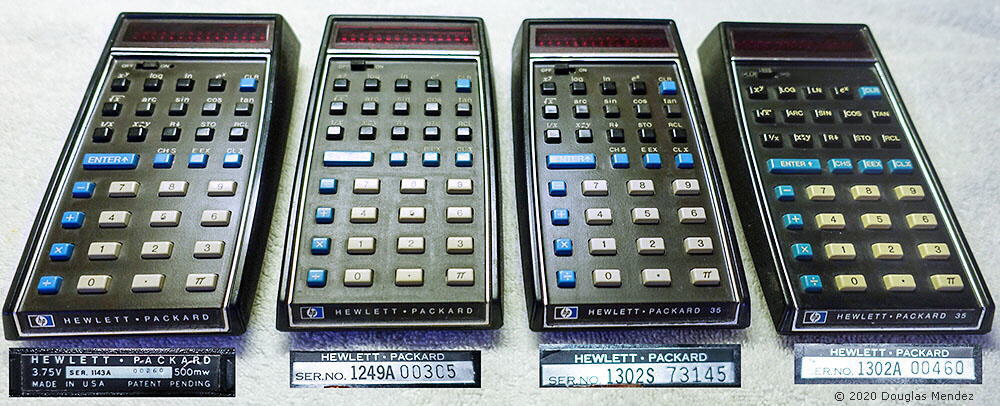
The Hewlett-Packard HP-35 was modified during the time that it was produced. Acquiring these variations is an interesting task for the admirer of this iconic calculator. Douglas Mendez has kindly provided this photograph of HP-35 calculators, together with the serial numbers on the labels on their backs, and information about them.
From left to right:
- Ser. No. 1143A 00260 - The earliest production model, labelled 'Hewlett●Packard', has two silver trim bars below the display, has a hole to the right of the OFF/ON switch which shows red when the calculator is ON ('red dot' variation), raised dot on the '5' key, originally had a ROM bug but apparently officially corrected in this example.
- Ser. No. 1249A 00305 - Labelled 'Hewlett●Packard', has two silver trim bars below the display, raised dot on the '5' key. Still has the standard ROM bug: enter 2.02 [ln] then [e^X] you get 2 whereas you should get 2.02.
- Ser. No. 1302S 73145 - Labelled 'Hewlett●Packard 35', has two silver trim bars below the display, 'S' in the serial number indicates assembled in Singapore.
- Ser. No. 1302A 00460 - Labelled 'Hewlett●Packard 35', has a single silver trim bar below the display, functions printed on the top bank of keys rather than the casing above them and these keys are rectangular not square.

The card HP-35 flat in the shirt pocket.
The story goes that after being shown the new HP 9100 desktop scientific calculator William Hewlett asked for a version to fit his shirt pocket[1]. This resulted in the development of the HP-35 featured on this page.
The HP-35 was a real game changer, packing the scientific functions into such a small package. To demonstrate the small size to potential purchasers the card model illustrated here was produced as a marketing item. As shown on the left it arrived flat in a sleeve made to look like a shirt pocket printed with the slogan 'The Shirt Pocket "Answer Machine"'. On withdrawing the flat HP-35 from the 'pocket' a rubber band inside caused it to spring to its actual 3D shape and size, as shown below.
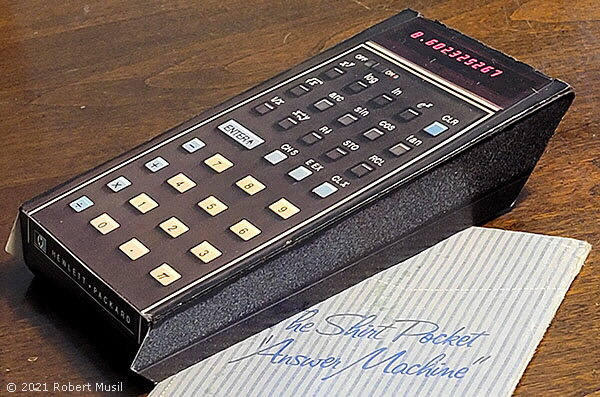
The flat card HP-35 springs to the 3D shape and size of the actual real calculator on withdrawing it from the pocket.
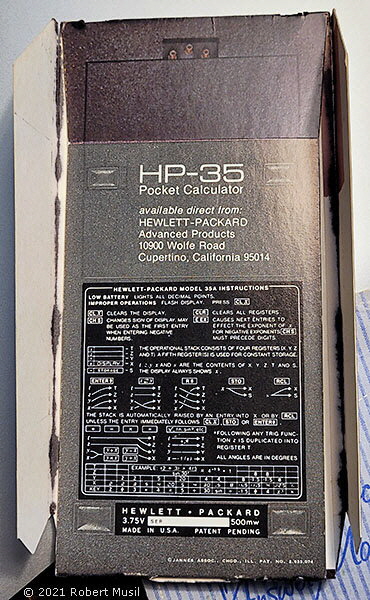
The rear of the card HP-35 carries the same list of operating instructions as the actual calculator.
Interestingly, the model number at the top of the instructions is here printed as "MODEL 35A". The first version of HP devices usually had the 'A' suffix, with later versions having suffix 'B', etc., but this was not actually applied to the hand-held calculators.
Grateful thanks to Robert Musil for supplying these photographs of this very unusual marketing item.
The press release for the award of the IEEE Milestone in Electrical Engineering and Computing for the HP-35 calculator (see below) says "Introduced in 1972, the HP-35 was the world's first handheld-sized scientific calculator. An instant hit, the HP-35 ultimately made the slide rule, which had previously been used by generations of engineers and scientists, obsolete.
The HP-35, named for its 35 keys, was the first handheld calculator to perform transcendental functions such as trigonometric, logarithmic and exponential functions.
In the first three years after its introduction in 1972, sales of the HP-35 Scientific Calculator exceeded 300,000 units."
This was the first hand-held scientific calculator. Previously, for their calculations, engineers and scientists would have used a slide-rule or a large desktop electronic scientific calculator. Now they could use a pocket-sized electronic calculator, if they could afford the price or persuade their company to provide one. Hewlett Packard calculators were very well made, and reliable, and their electronics instruments have always had a very good reputation. Together with the high specification, this made their calculators the models of choice for many professionals. In total, 300,000 HP-35 calculators were sold[2].
The cost of the HP-35 put it out of reach of many such as poor students, so other companies started to introduce scientific calculators with lower specifications and lower cost. While nearly all of the other calculator manufacturers concentrated on reducing the cost of their calculators, Hewlett-Packard largely maintained the price and increased the functionality. They launched the HP-65, the first hand-held programmable calculator, in 1974, though they did introduce their own lower specification and cost scientific calculator in the HP-21 in 1975. Hewlett-Packard are one of the few companies to continue making calculators from the early 1970s to the present day.
There is a lot of interesting information available about the HP-35, including:
- The article "The HP-35 Calculator: The first Electronic Slide Rule", in the 'Collecting Calculators' section of this site, has further information about the HP-35.
- The article "Purchasing an HP-35 Calculator in 1972", in the 'Collecting Calculators' section of this site, tells the story of one of the first students to purchase a Hewlett-Packard HP-35 scientific calculator.
- The HP-35 was described in considerable detail in the Hewlett-Packard Journal of June 1972.
- There is an enormous amount of information about the HP-35 gathered by David Hicks at the Museum of HP Calculators at http://www.hpmuseum.org/hp35.htm.
- There is a very interesting article "Made in the USA ... finally" about the development of the HP-35 on Rick Furr's calculator site, available in the archive at https://web.archive.org/web/20040203113550/http://www.vcalc.net/hp-35.htm.
- An article on the development of the HP-35, "The HP-35: Consumer Electronics, an Origin Story", at http://codex99.com/design/the-hp35.html
- An IEEE article "MOS CIRCUIT DEVELOPMENT FOR THE HP-35" at http://www.hpmuseum.org/forum/thread-3745.html.
- An article from the journal Electronics: "The HP-35: a tale of teamwork with vendors" at http://www.hpmuseum.org/forum/thread-3746.html.
- There is a lengthy video on Youtube with an interview with Dave Cochran who was involved in the development of the HP-35 at https://www.youtube.com/watch?v=0IlSjfgrHVM.
- If you would like to try out the "Reverse Polish Notation" operation of a very realistic virtual HP-35 visit Neil Fraser's site at https://neil.fraser.name/software/hp-35/.
Hewlett Packard awarded the "IEEE Milestone in Electrical Engineering and Computing" for the HP-35 calculator
On April 14th 2009 Hewlett Packard announced that it had been awarded the prestigious "IEEE Milestone in Electrical Engineering and Computing" for the HP-35 calculator, the first hand-held scientific calculator.
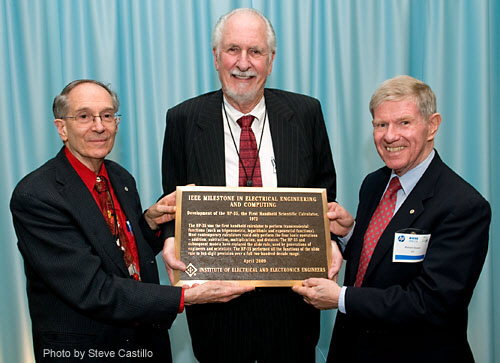
Left to right presenting the IEEE HP-35 Milestone Award are: Lewis Terman (IEEE), Dave Cochran (HP-35), Richard Gowen (IEEE).
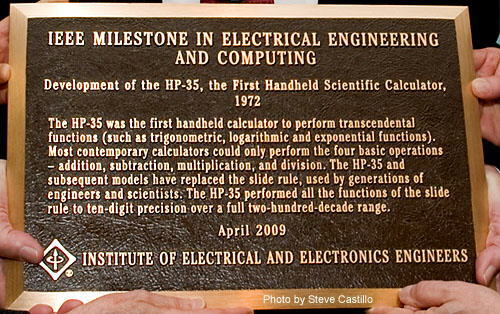
The press release of the award explains:
"Introduced in 1972, the HP-35 was the world's first handheld-sized scientific calculator. An instant hit, the HP-35 ultimately made the slide rule, which had previously been used by generations of engineers and scientists, obsolete.
The HP-35, named for its 35 keys, was the first handheld calculator to perform transcendental functions such as trigonometric, logarithmic and exponential functions.
In the first three years after its introduction in 1972, sales of the HP-35 Scientific Calculator exceeded 300,000 units.
An IEEE Milestone plaque recording the award will be permanently displayed at HP Labs in Palo Alto, Calif., the site where the HP-35 was originally developed."
July 2007: Hewlett Packard launches Retro HP 35s to Commemorate 35th Anniversary of First HP Handheld Calculator. More information on the Vintage Calculator News page.
Photograph of HP35s used with permission of HP.
See also the Hewlett Packard HP-80, the first hand-held business and financial calculator, and the Hewlett Packard HP-65, the first hand-held programmable calculator.
A Guide to HP Handheld Calculators and Computers
Revised Guide to HP Calculators Available
The fifth edition of Wlodek Mier-Jedrzejowicz's "A Guide to HP Handheld Calculators and Computers" has been published.
Reference:
Hand-held Calculators
Vintage Calculators
Text & photographs copyright, except where stated otherwise, © Nigel Tout 2000-2026.
